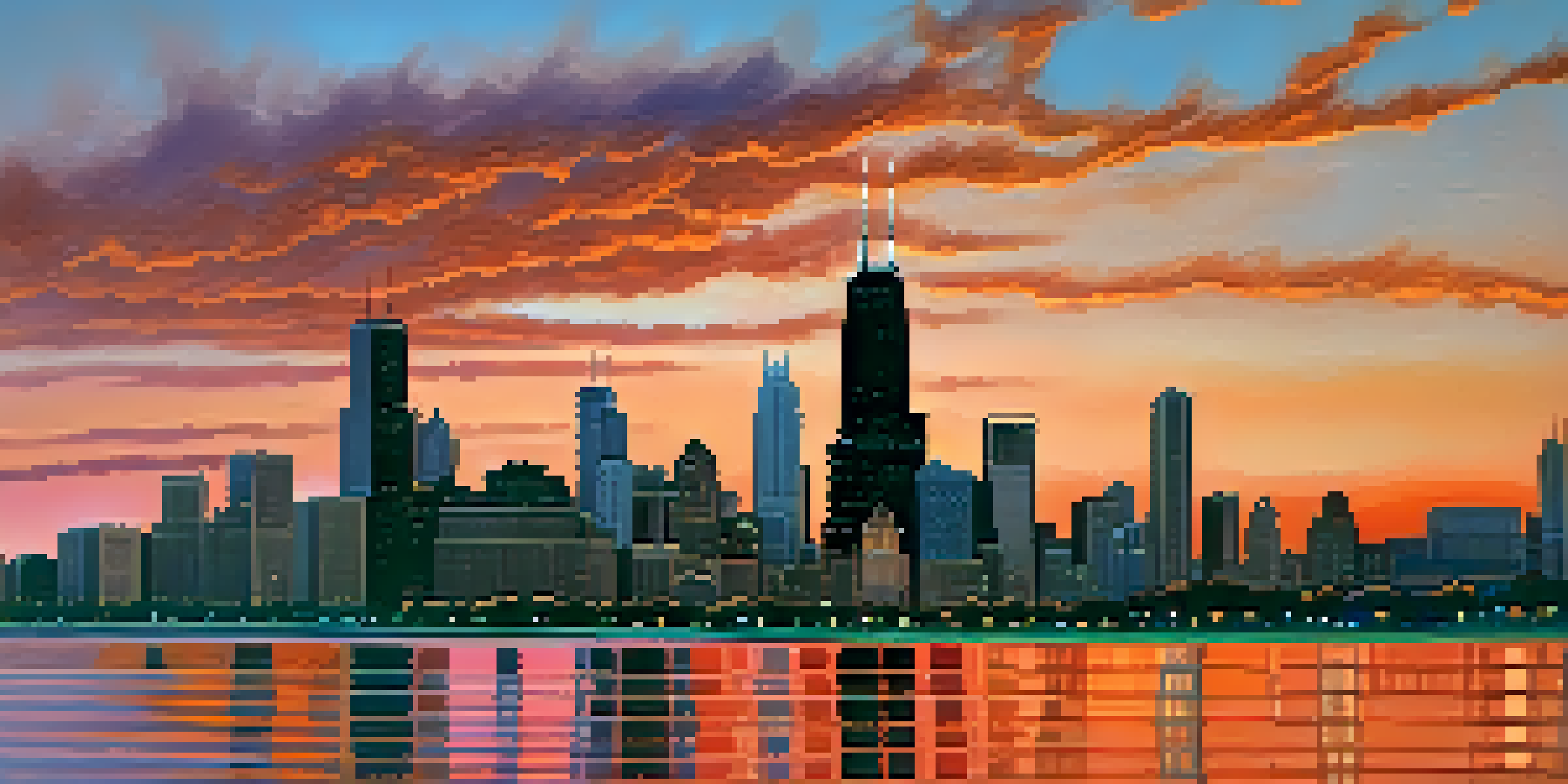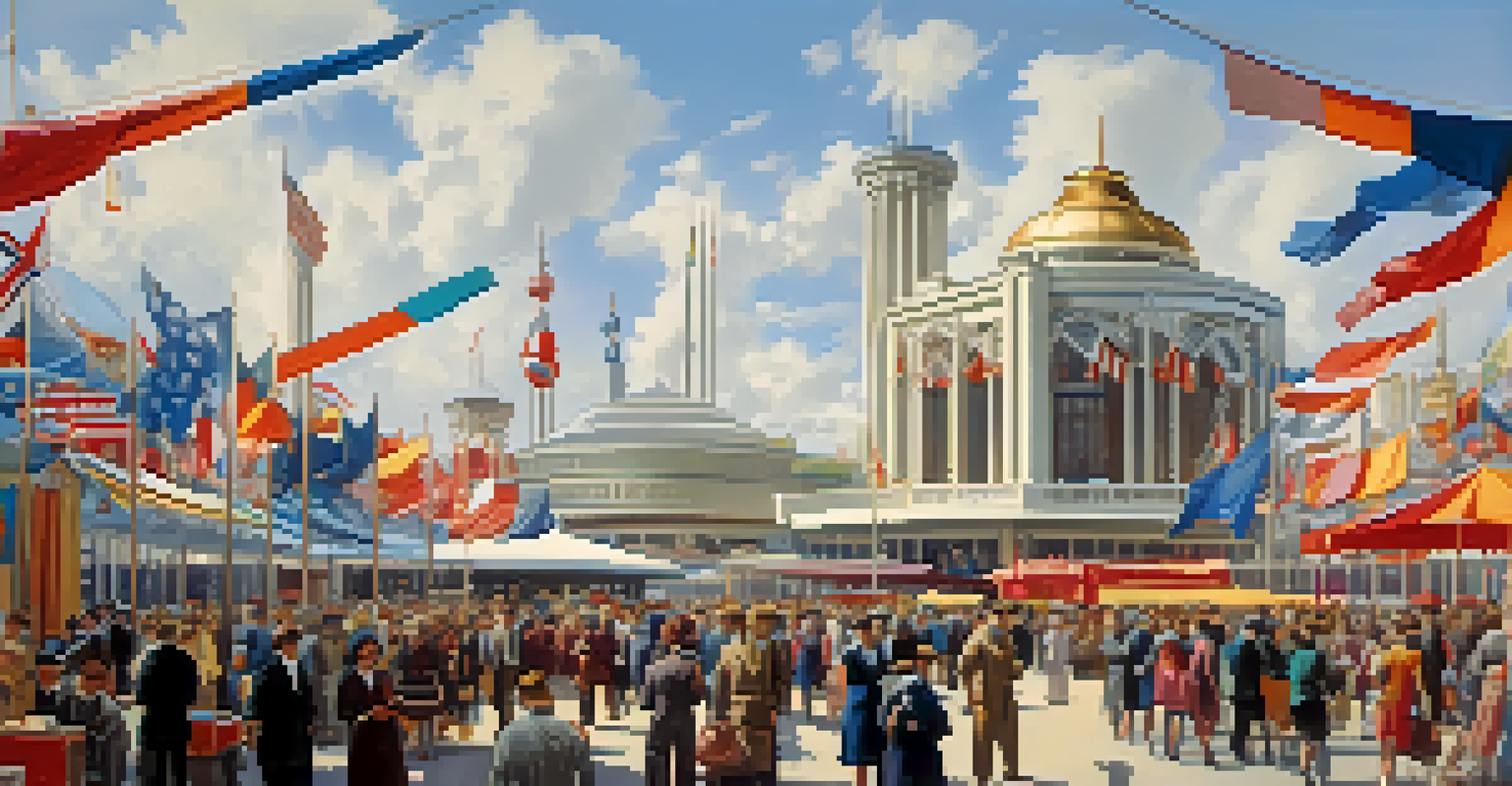Modernism in Chicago: The Impact of the Chicago School

The Origins of Modernism in Chicago
Modernism in Chicago emerged in the late 19th and early 20th centuries, driven by rapid urbanization and industrial growth. This transformation set the stage for innovative architectural practices that broke away from traditional styles. Influential thinkers and architects sought to redefine the urban landscape, emphasizing functionality and simplicity in design.
Form follows function—that has been misunderstood. Form and function should be one, joined in a spiritual union.
The Chicago Fire of 1871 was a pivotal moment, prompting a rebuilding effort that led to the development of steel-frame construction. This new technology allowed architects to design taller and more ambitious structures, marking a departure from the ornate styles of the past. As a result, Chicago became a laboratory for modern architectural ideas, attracting talents from across the nation.
With figures like Louis Sullivan and Frank Lloyd Wright at the helm, the Chicago School began to form its identity. Their philosophies emphasized 'form follows function,' advocating for designs that served practical purposes while still being aesthetically pleasing. This approach laid the groundwork for what we now recognize as modernism.
The Chicago School: Key Figures and Their Contributions
The Chicago School was not a formal institution but rather a collective of architects and designers who shared similar ideologies. Louis Sullivan, often deemed the 'father of skyscrapers,' championed the use of new materials and technologies, which allowed for the creation of iconic buildings like the Wainwright Building. His famous maxim, 'form follows function,' encapsulated the essence of modernism.

Frank Lloyd Wright, another luminary of the era, pushed the boundaries even further with his philosophy of organic architecture. He designed structures that harmonized with their natural surroundings, as seen in the famous Robie House. Wright's innovative use of open floor plans and integration of nature into architecture greatly influenced modernist design principles.
Modernism's Roots in Chicago
Modernism in Chicago emerged from urbanization and the Chicago Fire, leading to innovative architectural practices.
Other notable architects, like Daniel Burnham and William Le Baron Jenney, contributed significantly to the Chicago skyline. Their designs not only showcased modernism but also addressed the needs of a growing urban population. Collectively, these figures laid the foundation for a new architectural language that resonated throughout the 20th century.
Architectural Innovations of the Chicago School
The Chicago School is often credited with pioneering several architectural innovations that ultimately shaped modernism. One of the most significant advancements was the use of steel-frame construction, which allowed for taller buildings without compromising structural integrity. This innovation led to the creation of skyscrapers, transforming the city’s skyline and redefining urban living.
The fire destroyed the traditional buildings of the past and left a blank canvas for the new architecture that was to come.
Another notable innovation was the incorporation of large plate glass windows, which provided ample natural light and a connection to the outside world. This design element not only enhanced the aesthetic appeal of buildings but also improved interior environments, making them more inviting. It was a radical shift from the small, dark windows typical of earlier architectural styles.
The open floor plan was also a hallmark of the Chicago School’s influence. This concept promoted flexible, multifunctional spaces that catered to the changing needs of urban dwellers. As cities became more crowded, the idea of maximizing space while maintaining a sense of openness became increasingly relevant.
The Role of the Chicago World's Fair in Modernism
The 1893 Chicago World's Fair, officially known as the World's Columbian Exposition, played a crucial role in promoting modernism. It showcased the latest architectural trends and technological advancements, drawing international attention to Chicago as a center of innovation. The fair's neoclassical buildings, although not modernist in style, set the stage for a new appreciation of modern architecture.
Exhibitions at the fair highlighted the possibilities of steel and glass, inspiring architects to explore these materials further. The fair's success led to a burgeoning interest in modernist principles, encouraging architects to push boundaries and experiment with new designs. This newfound enthusiasm for modernism marked a turning point in the architectural landscape of the city.
Key Figures of the Chicago School
Architects like Louis Sullivan and Frank Lloyd Wright defined modernism with their philosophies emphasizing functionality and harmony with nature.
Additionally, the fair brought together diverse ideas and cultures, fostering a spirit of collaboration among architects and designers. The exchange of ideas and techniques during this period nurtured the growth of modernist architecture in Chicago, creating an environment ripe for innovation and creativity.
The Legacy of the Chicago School in Modern Architecture
The legacy of the Chicago School continues to resonate in modern architecture around the world. Its principles of functionalism and simplicity laid the groundwork for future architectural movements, including Bauhaus and International Style. These movements, in turn, influenced countless architects and designers who sought to embrace modernist ideals in their work.
Many of the iconic buildings from the Chicago School era, such as the Sears Tower and the Tribune Tower, remain significant landmarks today. They serve as reminders of the city's architectural evolution and the innovative spirit of its early modernists. Their designs not only define Chicago's skyline but also reflect the broader narrative of modern architecture's development.
Moreover, the Chicago School's emphasis on social responsibility and community integration continues to inspire contemporary architects. Today's designers strive to create spaces that not only fulfill functional needs but also enhance the quality of life for urban residents. This holistic approach can be traced back to the foundational ideas established by the Chicago School.
Modernism's Broader Impact on Urban Design
The influence of modernism extends beyond architecture; it has significantly impacted urban design as well. The Chicago School's principles encouraged planners to think critically about how buildings interact with their surroundings. This holistic approach led to the development of more functional and aesthetically pleasing urban environments.
Incorporating green spaces, pedestrian-friendly pathways, and efficient public transportation systems became essential components of urban planning influenced by modernist ideas. Cities began prioritizing the needs of their residents, creating environments conducive to social interaction and community engagement. This shift marked a departure from the purely utilitarian designs of the past.
Legacy of Chicago's Architectural Impact
The Chicago School's principles continue to influence modern architecture and urban design, promoting functionality and community integration.
As urban populations continue to grow, the lessons learned from the Chicago School remain relevant today. Modern urban designers are tasked with balancing sustainability, functionality, and aesthetics, all of which were championed by the Chicago School's architects. Their legacy serves as a guiding light for creating livable cities in the 21st century.
Conclusion: The Enduring Spirit of the Chicago School
In conclusion, the Chicago School's impact on modernism is profound and enduring. Its innovative approaches to architecture and urban design have shaped not only the city of Chicago but also the global architectural landscape. The principles established by its key figures continue to influence contemporary architects and urban planners.
As we navigate the complexities of modern urban life, the lessons learned from the Chicago School remind us of the importance of functionality, simplicity, and community integration. By embracing these ideals, today's designers can create spaces that resonate with the needs and aspirations of modern society. The spirit of the Chicago School lives on, inspiring future generations to innovate and reimagine our built environments.

Ultimately, the legacy of modernism in Chicago is a testament to the city's creative energy and its commitment to pushing the boundaries of design. As we look to the future, the principles and innovations of the Chicago School will undoubtedly continue to shape the evolution of architecture and urbanism.